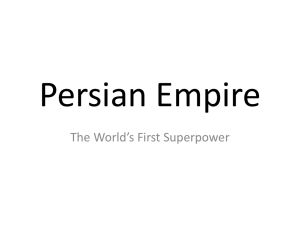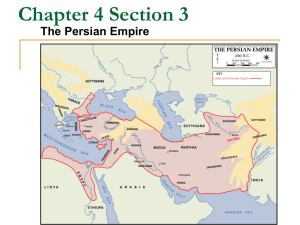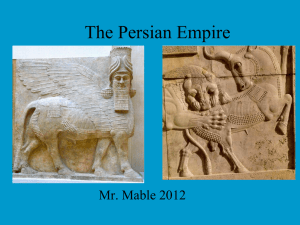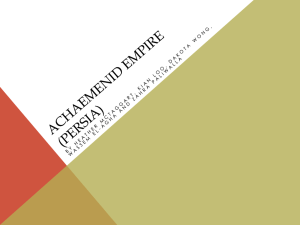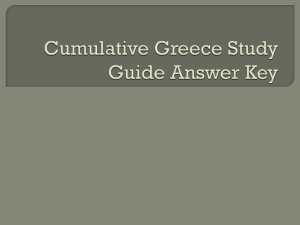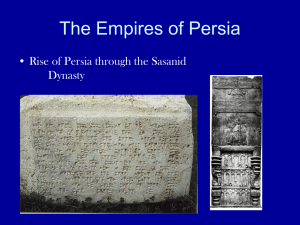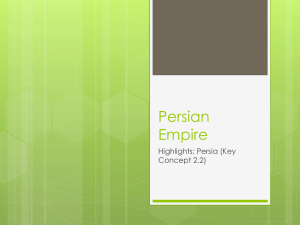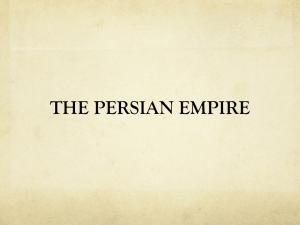Achaemenid Persian Empire
advertisement
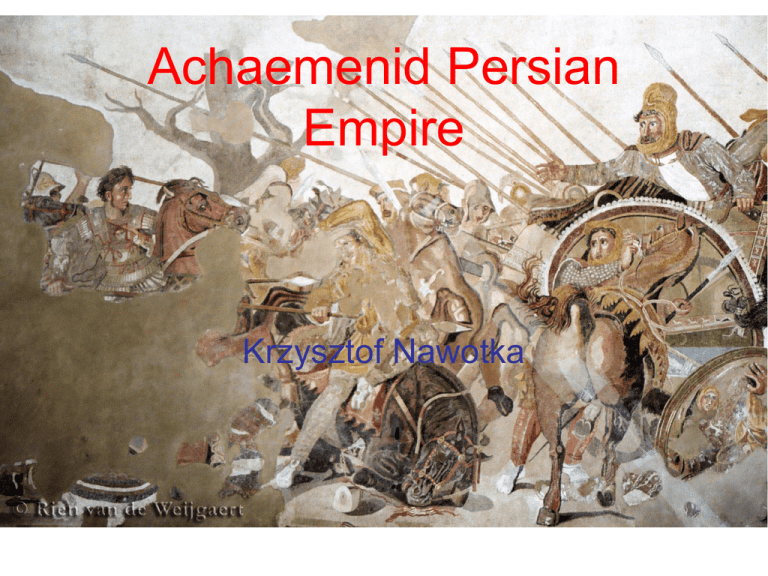
Achaemenid Persian Empire Krzysztof Nawotka Persian empire Rise of Persia 1 • Indoeuropean Aryans formed in stepps to the north of Black Sea and Caspian Sea • Ca. 2000 BC: conquest of India and Iran • In Iran: - nomadic and semi-nomadic society - 3 classes: priests, warriors, producers (i.e. peasants) - Clans, tribes and countries (dahyu) Rise of Persia 2 • Various Iranian states: Manna, Medes, Parsua (Zagros and Fars) • Trade with Babylonia and Assyria (Great Khorasan Road: forrunner of Silk Road) • From 9th c. BC Assyrian inroads in Zagros • 7th-mid 6th c. BC Media • 615-605 Kyaxares (Umakištar/ Huvaχštra) conquest of Assyria Cyrus II (the Great) • Kurush king of Anshan (Elamite city in Zagros) • Achaemenian dynasty: Hakhamanich (Achaemenes), Chishpish (Teispes), Kurush I, Kambujiya (Cambyses) • Allied with Nabonidus of Babylon, defeated and conquered Media 550 • Conquered Lydia 546 (?) or after 539 • Conquered Babylon 539 Persian empire • • • - Cambyses II: conquered Egypt 525 Fiscal crisis, rebellion of Gaumata 522 Darius I (the Great): Persian aristocrat, allegedly from collateral branch of Achaemenians - Supported by Persian aristocracy and army of Cyrus the Great - Reconquest of all provinces - Reorganization of empire Persian Empire under Darius I Persian empire (of Darius I the Great) • • • • • First universal empire Area: from Thrace to Indus valey Population: 30-50 million Divided into ca. 26 satrapies Four capital cities: Persepolis, Susa, Ecbatana, Babylon • Itinerant court: tradition of nomadic lifestyle, necessity to feed court and army Persia of Darius I: Susa palace Persia of Darius I: Persepolis Great King and his country 1 • Monarchy: Great King, King of Asia • King: elaborate costume, strict ritual, seclusion • POWs at Damascus (331 BC): 329 female musicians, 46 wreath makers, 277 cooks, 29 cooking specialists, 13 dairy specialists, 17 drinks specialists, 70 pourers of wine and 40 perfumers Great King Great King and his country 2 • • - King’s banquets: 1000 animals slaughtered every day PF: food for 12,000 people Luxury of King: to Greeks: unmanly decadence in fact: demonstration of King’s wealth, happiness and grace of gods, redistribution of wealth among courtiers and soldiers Persepolis - servants of the Great King Perisan servant on a Greek vase Great King and his country 3 • Roads: King’s Road Susa to Sardis (2400 km), good surface, postal stations, security • Elaborate administration: - known from Fars (PF, PT), to a lesser degree from Egypt, Palestine, Bactria - collecting taxes (mostly in kind) - issuing rations to aristocrats, officials, labourers - gift based economy Great King and his country 4 • • • • To Greeks: King/ despot and slaves To Persians: King and bandaka (vasals) King: warrior, hunter, builder Monarchy based on feudal principles of loyalty and life-long service for land grants • Satraps: - Iranian aristocrats with full power - Imitating King’s court and behaviour Persian army • 10,000 immortals (companions) • Garrisons in a few major fortresses • Mercenary force: superior Greek infantry, commanded by Persians, Greek officers incorporated to Persian nobility • Iranian: military settlers, aristocratic cavalry • Navy: Phoenician, Cypriot, Greek • War: mostly fought by satraps Immortals Persepolis – guard soldiers Persian religion 1 • Two epochs of Aryan religion : pagan (before Zarathustra) and Zarathushtrian • Pagan Iranian religion: - gods: of nature (e.g. Vata – brought rain), of cult (e.g. Fire - Atar, Water - Apo, Haoma) - Ritual purity - Cult of Fire: yasna with animal sacrifice, zaorta 3 times a day fuel added to fire • Mithra and Varuna - Hyposthases (personified abstracts) linked with Asha - Two types of obligation: *mithra – covenent, *varuna – solemn oath Persian religion 2 • • • Asha/aša: Law of nature: „truth”, righteuosness” Sustained by prayer and sacrifice Should guide our behaviour Virtue: fundament of normal world order Social virtues: truth, loyalty, courage Druj (lie) – opposite of asha People: ashavan (righteous), drujvant (base, liers) Persian religion 3 • Aryan religion reformed by Zaratushtra c. 10th c. BC following revelation by Vohu Manah • Holy book Avesta (6th c. AD) • Cosmic conflict between aša (truth) and druj (lie); aim of life: to sustain aša through good thoughts, words and deeds • Religion of choice and responsibility Magi Persian religion 4 • Ahura Mazda (Lord Wisdom): creator, god of aša, light, good, assisted by Amesha Spentas ("Bounteous Immortals") and by yazatas • Cosmic conflict with Angra Mainyu • King by grace of Ahura Mazda • Fire (atar): not god but agent of ritual purity, worshipped (fire altars and temples) • Priests – magi • Corpses exposed in towers of silence Fire worshippers in a relief of Gandhara Yazd: fire temple Ateshkade-e Ardashir: Sassanian fire temple Persian wars • Rebellion of Greek cities in Asia Minor 499-494 BC • Invasion of Greece by Xerxes 480-479 • Great battles: Thermopylae, Salamis, Plataea, Mycale • End in 447: Greeks of Asia Minor free • Tradition of Persian barbarity (destruction of Greek temples) and superior Greek military prowess Persian empire of the late 5th-4th c. BC • Successful Persian envolvement in Peloponnesian and Corinthian Wars: restoring Persian rule in Asia Minor • Independence of Egypt and great satrap revolt of 1st half of 4th c. BC • Artaxerxes III (358-338): suppresion of revolt of Phoenicia, pacification of Asia Minor, reconquest of Egypt Iranians in Asia Minor • Numerous aristocratic families endowed by the Great King with land for their services • Some gave origin to royal families in Hellenistic times: Pontus, Cappadocia, Commagene • Military colonists, e.g. in Cappadocia • Iranian cults: - Zaratushtrians well into 3rd c. AD - Iranian deities assimilated with indigenous gods of Asia Minor, especially Anahita with local goddesses - Mithra



